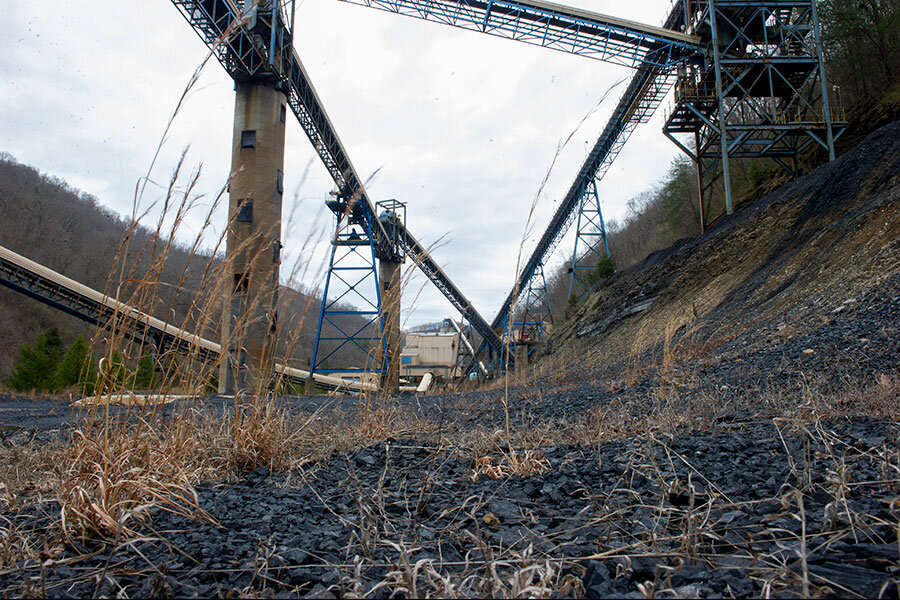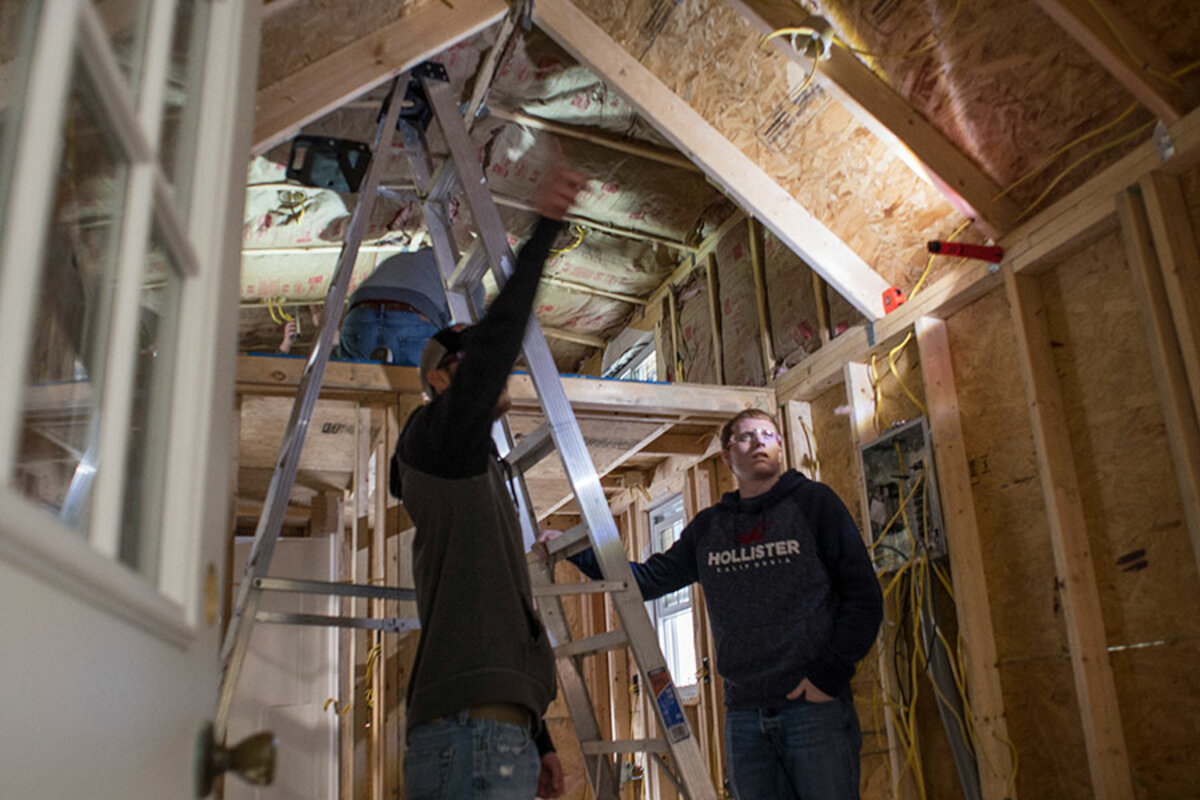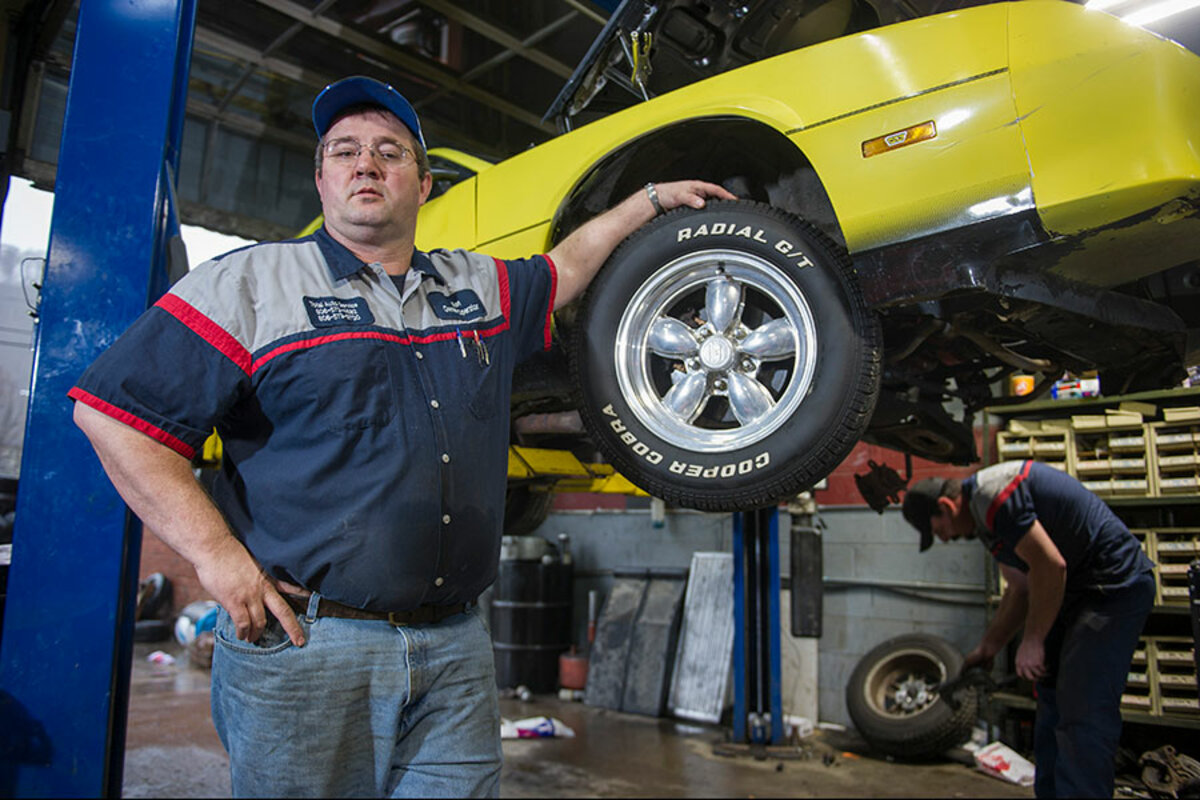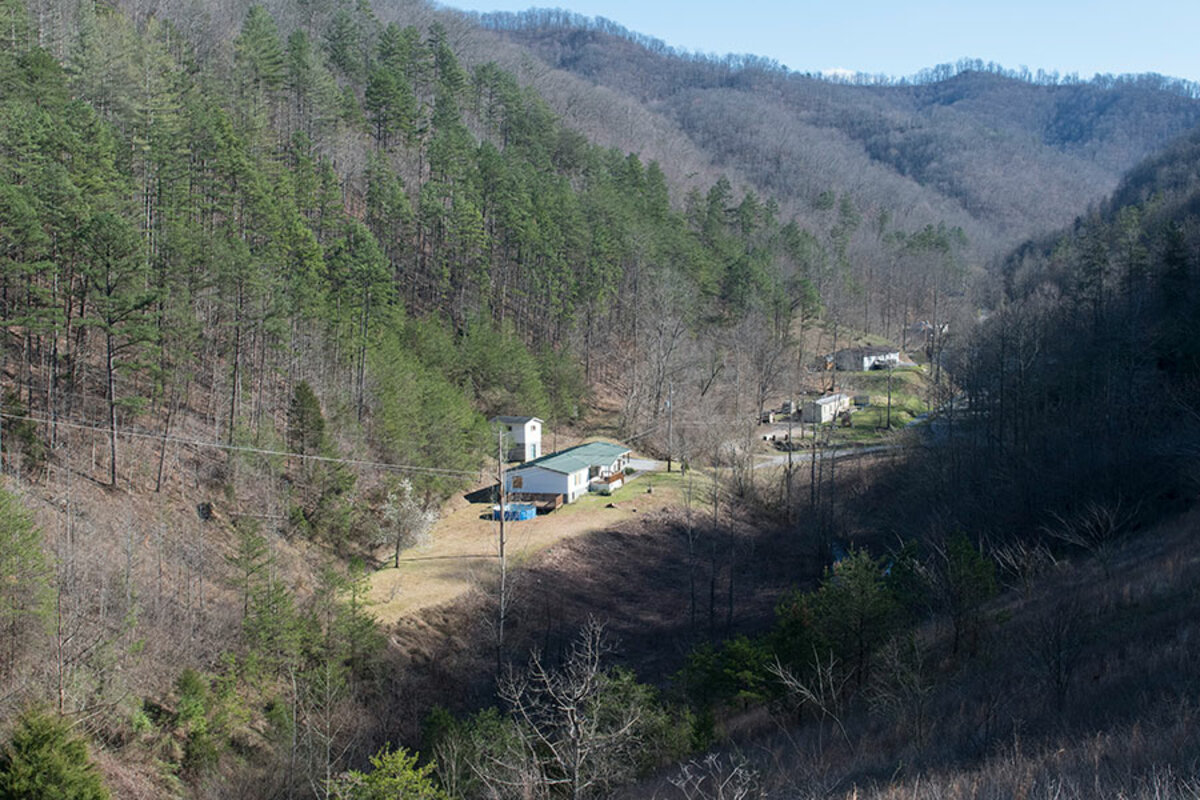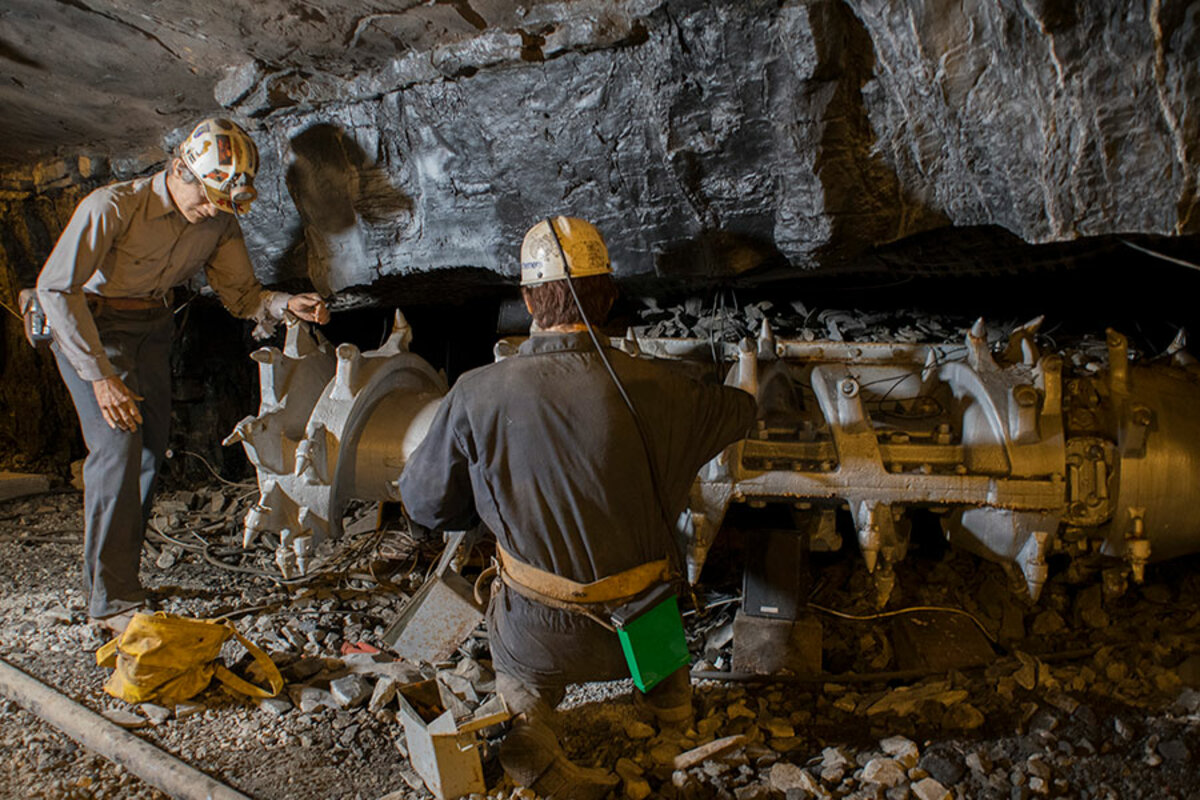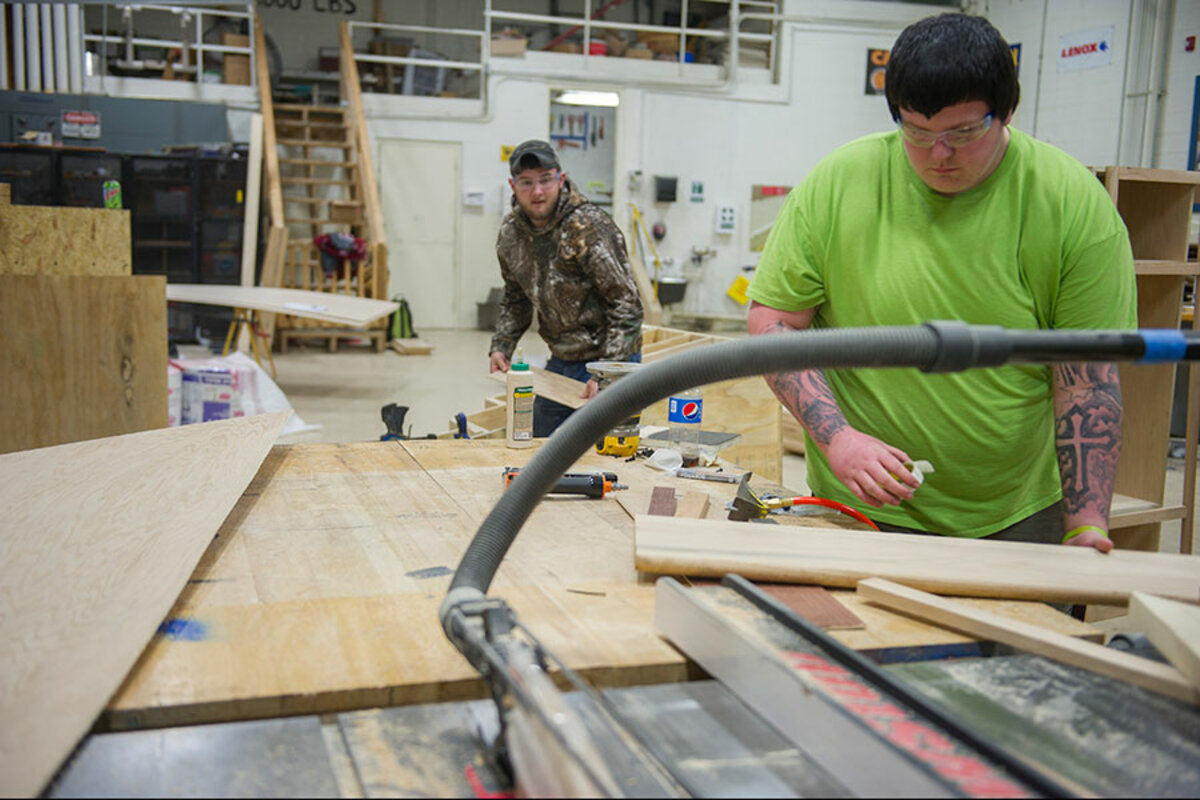Appalachia's new trail: finding life after coal
Loading...
| HINDMAN, Ky.
Teddy Martin knows the life of a Kentucky coal miner. He spent years working underground. Sometimes he burrowed through coal seams where the crawl space was just 28 inches high, so tight that “you had to pack a straw to drink your pop.”
It was hard, dangerous work. But it paid well – an allure that was obvious even back in high school, when Mr. Martin saw his friends graduate and come back with new cars. He wanted the same.
The problem: The work always ended. Mining jobs kept disappearing, and he was laid off half a dozen times. With each pink slip, he’d take community college classes to learn a new trade.
Now, that experience has given Martin a new mission – coaxing a young generation here to envision lives that don’t revolve around hauling solid black fuel out of the ground.
On this late-winter day, as a teacher at a vocational school, Martin is guiding his students toward the finish line in a “tiny house” competition. The contest pits them against students from two other nearby towns to see whose house, when sold at an auction, can net the most money for their school. But the real idea is not just to raise money. It’s to raise aspirations.
Tiny houses. Big dreams.
Martin, with a black ponytail and denim overalls, hopes that learning trades will allow his students to stay in Hindman after they graduate, and perhaps start businesses of their own right here. Many want to, but worry they can’t.
“I’m going to stay here as long as I can,” says Brad Breeding, a senior. “I was born and raised here. I don’t wanna leave home. But if it came down to it, I would.”
The tiny house project may seem exactly that – tiny. But it’s part of a coordinated effort that’s gathering momentum in Appalachian coal country, aiming to deliver opportunity to a region that has long stood as a symbol of persistent rural poverty in the United States.
For decades, coal supplied many here with a soot-stained, mountain-hollow version of a middle-class lifestyle. But even 50 years ago, near mining’s heyday, this craggy terrain was a focal point in President Lyndon Johnson’s war on poverty. Now, in a bid to move the region beyond reliance on either government support or a single uncertain industry, a broad web of local and national foundations, nongovernmental organizations, and civil society groups is trying to resurrect eastern Kentucky and other parts of America’s penurious Coal Belt.
Perhaps more than at any time in the past, the focus is on bootstrap ingenuity – encouraging a more entrepreneurial economy. The goal is not just to pump money into the region, but to help communities like Hindman foster the desire and have the tools to build a new future for themselves, one small business at a time.
“We’ve been waiting for someone to come in and save the day,” says Kelly Hall, innovation director at the school where Martin works, the Knott County Area Technology Center. “But I think the answer lies within.”
If the vision is impressive, so are the region’s challenges. Here in Knott County, for example, the roughly 10 percent unemployment rate is twice the national average, on top of an unusually high rate of adults not even entering the workforce to look for a job. The 33 percent poverty rate is more than twice the national average. Kentucky has among the nation’s highest rates of drug-overdose deaths, and the rate in Knott County has been among the highest in the state.
Donald Trump made the revival of coal jobs a big theme in his successful campaign for the presidency. But to energy industry experts, any turnaround looks likely to be modest at best, given the long trend of decline that has brought eastern Kentucky coal employment from 66,000 in 1948 to fewer than 6,000 as of 2015.
Many in this region have some Trump-inspired hope for a coal rebound. The longstanding link to mining here is hard to break. But residents also know that President Trump can’t wish away the forces – mechanization in the mines and competition from abundant natural gas – that have driven coal’s decline. To many, the region simply has no choice but to adapt and diversify.
Towns like Hindman, across a mining region that runs through the ancient folds of the Appalachian Mountains, from Pennsylvania to West Virginia to Tennessee, are beginning to see the opportunities – in fields such as tourism, agriculture, e-commerce, and environmental cleanup.
“There are a lot of different smaller things,” says Jeff Wilder, who heads the tourism office in Harlan County, 60 miles south of Hindman. “I think a lot of people here have decided to use their ingenuity to do other things [than coal].”
Perhaps more important, young residents like Mr. Breeding have one advantage over generations past: They’re growing up without the deep-rooted loyalty to coal mining that their parents and grandparents harbored. As his classmates scale ladders around the tiny house, or slide underneath it on wheeled carts to install plumbing and insulation, they are looking to a different future.
The old mind-set that the region needs a big jobs provider – like coal – is hard to break. Younger generations watch their parents endure unsteady employment and worry about their own prospects. Older generations can’t visualize a different way forward.
One mistake outsiders make, many here say, is thinking all this is actually about coal. It’s not. It’s more about the life coal provided. Where else could you earn $80,000 a year with a high school education or less?
“Embrace the change or be left behind,” says Jeff Combs of Hazard, Ky., standing outside a bed-and-breakfast on a hill overlooking the community’s nearly vacant downtown. “Be open-minded. Be open-minded to more.” Mr. Combs’s father, a former coal miner, implored him to avoid the mines. It was tough work, dangerous and unhealthy in the long term. Combs’s father was on disability in his 50s.
Allen Jones has been through the hard rhythms of eastern Kentucky as well. For him, as for many in the region, jobs in the mines started to vanish.
“I’ve worked underground. I’ve slept underground. I’ve duckwalked. I’ve climbed ladders,” he says. “Yeah, I wanna go back in. It’s in your blood.” Sleepless nights followed his exit from the coal industry five years ago. Anxiety over how he’d provide for his wife and three children gnawed at him.
Now, Mr. Jones owns two auto-repair shops. He started his business with a loan from the Kentucky Highlands Investment Corporation, a local venture capital group that provides financing for new businesses. He’s since turned into an investor himself, loaning neighbors money during hard times. Jones lost on several deals, but says helping his neighbors is his duty because of his “ties with people in Harlan and seeing how hard they’re having it.”
While Jones constantly has “the itch” to get back underground, coal isn’t necessarily the answer to the region’s future. “We don’t care what it is,” he says. “We just want to work.”
It pains Jones to know young people don’t feel they can stay in eastern Kentucky. He wants his children to take over the family business, but knows he can’t force them.
“If you apply yourself right, you can start your own business even in a small town like this,” he says.
That’s what many civil society groups are certainly hoping. Regionwide, the entrepreneurial push started in earnest in 2010 when philanthropies and investors banded together to form the Appalachia Funders Network, steering grants toward economic diversification.
Kentucky, home to some of the poorest corners of Appalachia, has gotten involved, too. Business and political leaders have backed an initiative called Shaping Our Appalachian Region, which in turn has attracted federal grants.
Climate change is an impetus for some of the efforts. Environmental advocates say it’s disingenuous to promote policies that curb greenhouse gas emissions and pollution without supporting affected communities. The Sierra Club, for example, is trying to help fashion a new economy.
What really ties the initiatives together, though, is the focus on seeding new businesses and jobs that have been lacking as coal mining has plummeted for several reasons: first, because of mechanization; then because of technological advances that allowed power plants to burn dirtier Midwest coal; and, finally, because of competition from cheaper natural gas, and the costs imposed by former President Barack Obama’s environmental regulations.
Trump has pledged to stem the industry’s decline, but, beyond removing some of the environmental rules, many believe his options are limited. His proposed budget, meanwhile, would cut into federal support for the region. Notably, he calls for eliminating the Appalachian Regional Commission, an economic development initiative that’s been running since 1965. The proposed cuts are causing concern among many Kentucky Republicans as well as Democrats.
They come as towns are already struggling with their finances. Vital government funding from severance taxes imposed on coal companies has been waning as the industry has declined. Whitesburg, a town with a concert venue, media arts center, and a couple trendy restaurants, is debating selling its recreation center and raising taxes to offset a $1.3 million shortfall.
“Transitioning is tough,” says Jim Ward, the judge-executive for Letcher County, in which Whitesburg is located. “We’ve just got to figure out how to do it. And we’re just at the beginning of it.”
Mr. Ward hopes expanding broadband internet access will open up telecommuting and e-commerce opportunities. Kentucky Republican Gov. Matt Bevin has made attracting tech jobs one of his biggest economic diversification goals.
Some policymakers are looking at other ways to help. Sen. Shelley Moore Capito (R) of West Virginia has introduced legislation in Congress to set aside $525 million for a “new market tax credit.” It is intended to spur private investment in distressed former coal communities in Appalachia.
In Kentucky, the state Senate is considering a bill that would put $7.5 million of the annual coal severance tax revenues into a trust fund for economic diversification.
Russell Huff, a business owner in Harlan who is also an amateur rapper, says the time for diversification is ripe because eastern Kentucky has its most educated workforce ever. The younger generation grew up without expecting a coal job, so they went to college instead. He’s taught welding to many of them at a community college.
Mr. Huff owns a race car shop, though it most closely resembles a pawn store. His most recent find is a white BMW two-seater, bought on the cheap (he claims it was found at the bottom of a swimming pool in a drug seizure). People called him crazy for opening a business in a “ghost town.” He doesn’t mind. Most of his business is online anyway, selling cars he fixes on eBay. Huff says his students could do more with e-commerce.
“Everybody thinks that running a business [means] they’re going to be millionaires overnight,” Huff says. “You can hang your name in the window and not be a millionaire, but you won’t be at Wal-Mart wearing a little blue vest. There’s a lot of people who could do that.”
While creating new businesses isn’t easy, the Knott County Area Technology Center, the vocational school involved in the tiny house project, exemplifies one way the new entrepreneurial network here works.
The $15,000 grant the school won to help create new jobs is part of a Kentucky Valley Educational Cooperative contest. That nonprofit wants to develop technical curriculum to better prepare students for emerging fields. The Bill & Melinda Gates Foundation funds some of KVEC’s push, as does a $30 million federal education grant. All the while, KVEC helps 19 school districts make inroads with local businesses and civic leaders to strengthen employment pipelines.
“We’re creating opportunities to build out career pathways in areas that won’t necessarily contribute to the brain drain that’s taking place in the area and has been for 50 years,” says KVEC executive director Jeff Hawkins. “We’re trying to reinvent the community in some way.”
That’s why Brad Shepherd returned to the region with his partner, Daryl Royse. They were tired of city life in Lexington, Ky., and wanted to move somewhere they felt they could make a difference. They settled on Whitesburg and opened Heritage Kitchen, a comfort food restaurant that uses locally sourced ingredients.
“We offer something different,” Mr. Royse says.
“But we’re not a health-food business – we’ve been accused of that,” Mr. Shepherd adds, laughing. They’re certainly not. There’s a homemade veggie burger on the menu, but the (delicious) hash brown casserole is swimming in a pool of oil.
Shepherd says there’s plenty of opportunity in Whitesburg for workers who know a trade. It took them three weeks to get their ice machine fixed, and the technician came from Lexington, about 150 miles away. But Royse says finding committed employees is difficult – they’ve been trying to fill openings for months.
“People are just sort of stuck,” says Royse. “It’s an in-between time in that there’s a sense of loss that they don’t know what to do.” But he’s optimistic. His business has beat expectations every quarter. “Sometimes it’s not a quick fix,” he says. “Sometimes it’s a long-term collaborative effort.”
Portal 31 in Lynch, Ky., is perhaps the most apt metaphor for the region’s hopes: It’s an old mining site that has been transformed into a tourist destination.
Filled with $4 million of animatronics, it includes a 45-minute tour that takes visitors into the bowels of a decommissioned mine – a 13-mile-deep underground city.
The dampness permeating the subterranean warrens is still very real. Much of the “coal” is not – many of the displays are fiberglass. To Don Elliott, walking through this dark mine of the past with a hand-held miner’s lamp shines a light on the future.
“I would love to see the tourism industry flourish here,” says Mr. Elliott, who mined coal for 39 years. “I think it can. I would love to see any kind of business come here and employ people so that kids want to stay.” Royse, who ran for city council in Whitesburg, has been prodding Kentucky’s leaders to clean up abandoned mines. If state and local leaders could return mining-scarred mountains to usable flatland, that would open up areas to all kinds of development.
One reclaimed mine is already the site of a gated housing development, “The Meadow,” in Knott County. Farther up the road, more than 100 miles of trails for all-terrain vehicles and elk-hunting grounds have emerged on reclaimed lands. Zip lines in nearby Evarts, Ky., offer another form of recreation.
With a more coordinated marketing effort, the tourist trade in eastern Kentucky might be able to flourish and match that of southern Virginia, just over the other side of Black Mountain. Some people are already working to make that happen. Brook Smith, a Louisville-based businessman who made his fortune in surety bonds on reclaimed mines, is recruiting other like-minded social impact investors to channel money into eastern Kentucky.
“We do think that there is momentum with projects around tourism and culture and arts and ecotourism in the region, and we can help support that in some ways,” says Lora Smith, who is advising Mr. Smith on his philanthropic endeavors.
Shane Lucas represents another attempt to revitalize the region – one lettuce leaf at a time. He operates a small farm in the Appalachian foothills near Whitesburg.
His spread includes a sizable greenhouse where rows of purple-green lettuce sprawl across the floor. He’ll sell three bushels to Heritage Kitchen this week, but his big payoff is when the farmers market opens in the spring. The market accounts for at least half of Mr. Lucas’s farm income.
“Growing is easy. Marketing is hard,” says Lucas, walking around his greenhouse in camouflage rubber boots and a hooded sweatshirt.
Through a program called Grow Appalachia, Lucas is encouraging others to take up farming. He teaches them how to tend to their own gardens. Like many people here, Lucas was once a coal miner. But when he was last laid off in November 2015, he turned his hobby into a full-time business.
Lucas is honest, though – if his wife didn’t have a job and health insurance, he wouldn’t be farming. He’d be tempted to go back to the mines if they reopened, even at a steeply reduced salary if it came with benefits.
Still, he thinks there’s potential for agriculture in eastern Kentucky. Many in the development community do, too.
“Eastern Kentucky has always been about food,” says Kathy Curtis, who works with the local group Community Farm Alliance. “When people start out, they always go back to their roots.”
Whitesburg has a unique setup for farmers through a local nonprofit. The
FARMACY program, run by Mountain Comprehensive Health Corporation and Community Farm Alliance, gives low-income residents “prescriptions” for fruits and vegetables. Patients purchase produce with wooden chips, which sellers like Lucas exchange for cash. It encourages healthy eating – and new jobs. “The big talk in Whitesburg is the farmers market because there’s so much money rolling in from the health-care providers,” says Lucas.
Right now, the students at Knott County are just trying to finish their tiny house.
Chris Hall is in the shop room building cabinets. Mr. Hall plans to go to college after he graduates. His dad, a former coal miner, wants his son to do anything but work underground. Hall says he will come back on weekends to see family and friends.
The yearning to return, even if temporarily, is common. T.J. Short, a burly redhead who’s heading to West Virginia to dig coal after graduation, says he, too, plans to come home on weekends. He doesn’t know how long he’ll have his job anyway.
“I’d be lying if I said I wasn’t scared, but I hope it works out there,” says Mr. Short of his mining venture.
One day these students may not have to leave the area to begin with. That will depend on whether a new Appalachia can be created. Many of the students have already taken the first step: They’re pinning their future hopes on something other than coal.
But the second step, finding something else to do, will be harder. Yet many of those wielding hammers and screw guns here harbor the boundless idealism of youth. “All businesses, when you start out, are going to be rough,” says Billy Spears, who will run a logging company with his grandfather after graduating. “It’ll pay off in the end.”
Tiny houses. Big dreams.




